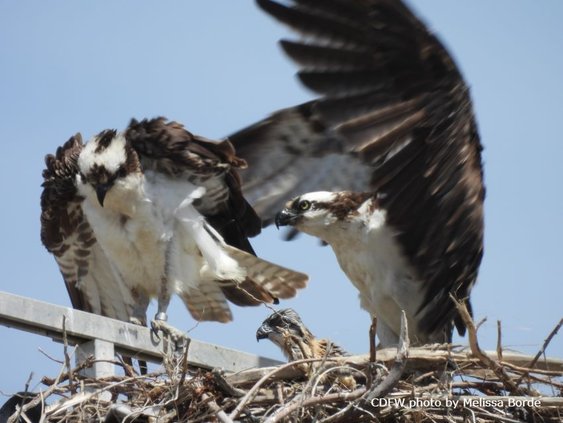

Osprey
Q: Do osprey have their own taxonomic classification?
A: Yes, osprey are the only species in the Pandionidae family in the entire world. They are also the only raptor with a unique foot morphology adapted for catching fish. Osprey talons are more curved than other raptors, and they have spines on the pads of their feet that adhere especially well to fish scales. They can also rotate their outer toe so that two toes face forward and two face backward, which helps them grip fish.
Osprey can be found near almost any body of water, but they primarily breed in the Northern Hemisphere and winter in the Southern Hemisphere. They can be found year-round in Australia, Indonesia, Papua New Guinea and the surrounding islands. In California, osprey typically breed from the Cascade Ranges to Lake Tahoe, and along the coast south to Marin County. For more information visit CDFW’s Raptors of California webpage.
Leopard shark
Q: I heard about a leopard shark sighting in Oakland’s Lake Merritt. Is that unusual?
A: No, it is not unusual. Lake Merritt connects to the San Francisco Bay via a channel and the Oakland Estuary. Marine species regularly travel into the “lake,” which is technically a tidal lagoon. Leopard sharks live in shallow waters of bays and estuaries and nearshore in both kelp forest and sandy environments. They are abundant along sandy beaches of Southern and central California. During the fall, large numbers may be found in San Francisco and Monterey bays.
If you’re interested in marine species, consider subscribing to CDFW’s Marine Region News Service. Subscribers receive news and blog posts about fishing regulation changes, interesting fish and invertebrates, ocean monitoring, species management, research and more. You can also learn about leopard sharks and other California fish and invertebrates on CDFW’s Marine Species Portal.
Fly rod
Q: I like to go to my local lake and practice casting with my fly rod. I have a small weight at the end of the line, but no hook, bait or lure. Do I need a sportfishing license to do this?
A: No. If you don’t have a “means of take” such as a hook or a lure, then you are not required to have a fishing license.
Fish as bait
Q: Can I use fish I catch in lakes and rivers as bait for other fish?
A: It depends on where you’re fishing. The regulations that outline allowable use of fish as bait for each fishing district can be found in the 2023 Freshwater Sport Fishing Regulations Booklet (PDF) under Article 3 (page 19). As an example, in some inland waters of California, you can use fin fish that you catch as bait if you are angling in waters specified in Article 3. The following fishing districts allow for the take of some fish species for use as bait in specified waters: the Southern, Colorado, Valley, South-Central, North-Central, Sierra and North-Coast districts. One of the important reasons why bait fish use is regionally regulated is to prevent inadvertent introduction of that bait fish to waters where it does not currently exist.
Note that any fish you catch which has a daily bag limit, when used as bait, must be counted toward that daily bag limit. For example, the daily bag limit for bluegill is 25. If you catch three bluegill and use them as bait, you’d count all three toward your daily limit of 25.
If you have a question you would like to see answered in the California Outdoors Q and A column, email it to CalOutdoors@wildlife.ca.gov.





